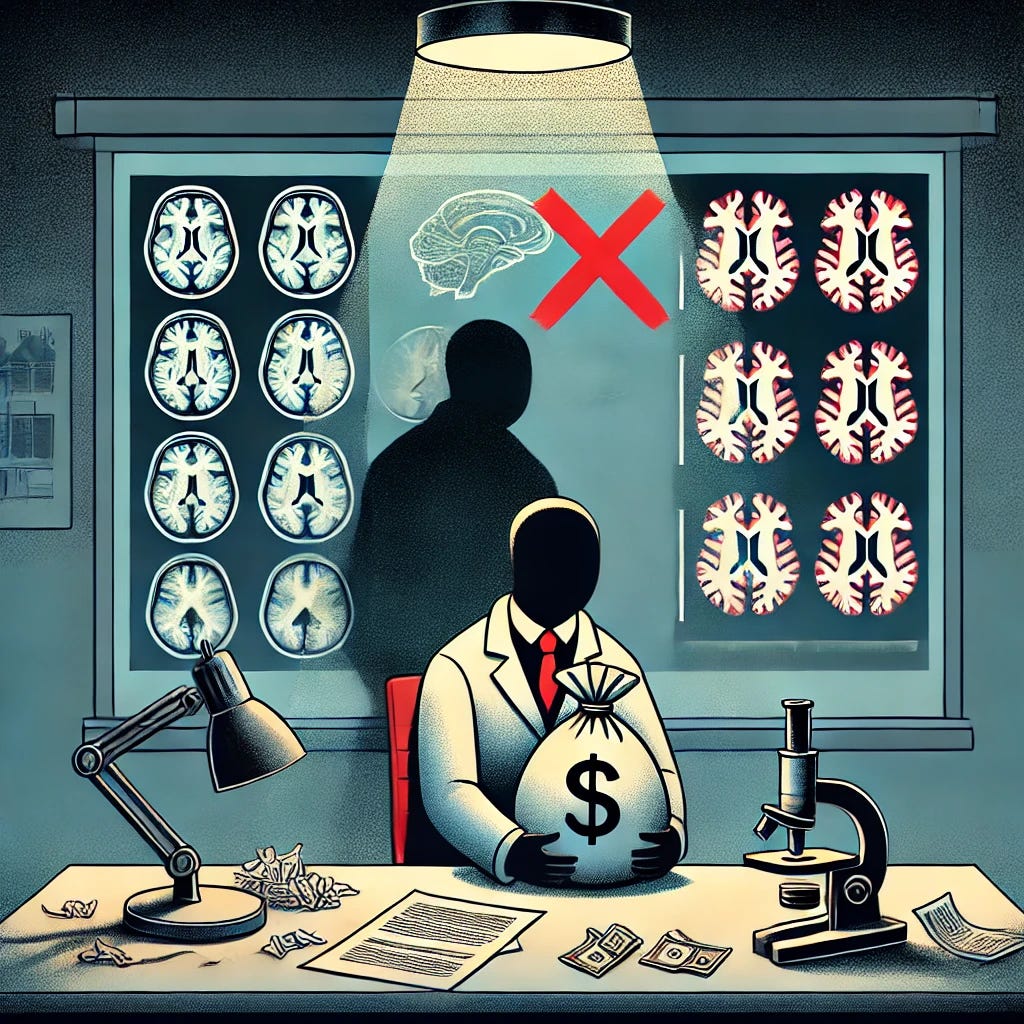Alzheimer's Disease Research Fraud: From Hope to Hoax.
How a forged study wasted billions of dollars and cost countless lives.
In a field where a treatment discovery might mean a lifeline for millions, few bombshells have rocked the scientific world quite like the fraud in landmark Alzheimer’s disease research.
Let’s start at the beginning, Alzheimer’s disease is a neurodegenerative condition that slowly damages the brain and causes problems with memory, thinking, and everyday activities. Imagine trying to remember a friend’s name or how to get home, but the details slip away no matter how hard you try. Imagine looking at someone you’ve known for decades, and their face is unrecognizable, like a complete stranger. This is life with Alzheimer’s disease.
There are an estimated 6.5 million people living with Alzheimer’s disease in the U.S.
Alzheimer’s is the sixth leading cause of death in the U.S.
It’s estimated that 1 out of 3 elderly Americans will be diagnosed with Alzheimer’s or other-related dementias.
The total cost of treating Alzheimer's disease in the United States is estimated to be $345 billion.
In 2022, it was found that a foundational piece of research on Alzheimer’s was based on purposely manipulated images and falsified data.
The research centered on the idea that clumps of amyloid beta (Aβ) proteins were at the root of Alzheimer’s disease. The amyloid beta (Aβ) hypothesis posits that Alzheimer’s disease starts when sticky Aβ fragments accumulate and form plaques in the brain. Over time, these clumps disrupt normal cell-to-cell communication, eventually triggering the memory loss, confusion, and other hallmark symptoms that were thought to define the disease.
The research fraud was uncovered when Matthew Schrag, a neuroscientist at Vanderbilt University, was reviewing data related to an Alzheimer’s treatment and noticed irregularities in crucial images from the Aβ research. Investigating further, Schrag discovered telltale signs of image manipulation—bands that seemed copied and pasted, and suspicious duplications that didn’t align with natural experimental outcomes. To validate these suspicions, he consulted independent specialists, including seasoned image analysts, who confirmed the likelihood of tampering.
Upon further investigation, the study in question was retracted and a massive blemish was placed on the peer review process used by medical journals. If that piece of fraudulent research slipped by, how many others have as well?
For decades, the “amyloid hypothesis” was the cornerstone of Alzheimer’s research and drug development. Nearly every major funding decision, pharmaceutical investment, and early detection strategy drew inspiration from the idea that blocking, clearing, or managing amyloid plaques could halt this brutal disease.
Since 1995, private funding for clinical stage Alzheimer’s research has reached over $42.5 billion.
The federal government’s annual investment in Alzheimer’s and dementia research is over $3.8 billion.
The impact and implications of this research fraud are staggering. Billions of dollars have been wasted, precious years of potential progress squandered, and—most importantly—countless lives lost. To date, no major breakthroughs have occurred in the treatment of Alzheimer’s disease, and it remains a death sentence.
What does it say about the oversight in our regulatory agencies and healthcare institutions if fraudulent research can go unchecked, for over 16 years?
For part 2 of this article, I’ll be doing a deep dive on the actual root causes of Alzheimer’s disease, stay tuned!
Please restack, like and share this article to spread awareness!
A great deal of time and effort goes into the research presentations and video production here on Health Uncensored. If you find value in this publication, please consider becoming a paid subscriber. It’s $5 dollars a month, which is about .17 cents a day. Your support is greatly appreciated.
By becoming a paid subscriber, you are supporting Substack as well, and keeping this platform free from censorship and conflict of interest-ridden advertisers.








Alzheimer’s can be caused by an undiagnosed bladder infection. Surprise! No money in that!!
The real cause cannot be revealed as it would step on the toes of the offending industry. The goal is to create a scary boogey man and fear, concoct, establish and harness a plausible and expensive solution and market that concept with the marketing team (research) and watch the tsunami of cash wash is and excite the investment analysts at the quarterly earnings conference call. Ta-daaa. This is the only result that can occur under the commodification of any processes that provide any semblance of a public good.